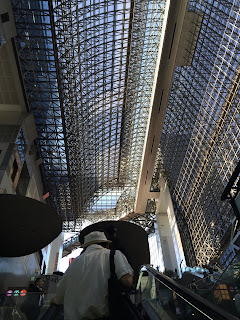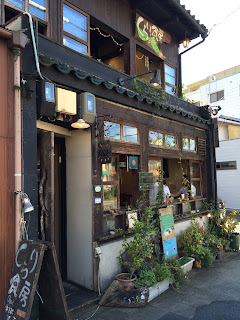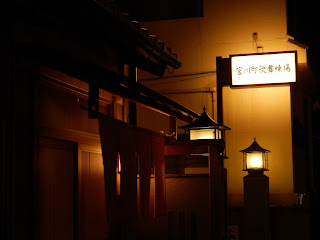 |
| Map showing all the places I'll visit in Kyoto - it says Osaka at the top, but it's Kyoto.... :D |
 Woke up again early to leave Osaka and make my way to Kyoto, just 1 hour away by train. The good thing is that Yodoyabashi station has a train straight to Gion Shijo station in Kyoto so that saves time and money (only JPY 410 for the trip and I got on an express train that was double decker and looked really nice).
Woke up again early to leave Osaka and make my way to Kyoto, just 1 hour away by train. The good thing is that Yodoyabashi station has a train straight to Gion Shijo station in Kyoto so that saves time and money (only JPY 410 for the trip and I got on an express train that was double decker and looked really nice).When I arrived at Gion Shijo station and got above ground, I was surprised at how busy the street is. This is the main street of Kyoto I think.... at least for tourists. There's lots of shops selling Japanese sweets packaged all nicely for tourists to purchase as souvenirs.
If you go east, you'll go into Gion where there's lots to see and some of the biggest and most venerable shrines.
If you go west there are more shopping opportunities along the main street and in all the little street that go north and south of Shijo. My "hotel" is located to the west of Shijo and just about one big block south, so very convenient and close to Shijo station (not the same as Gion Shijo station).
I ended up choosing to stay at First Cabin Kyoto Karasuma because I wanted to experience a capsule hotel and also because hotels in Kyoto were more expensive than in Osaka and Okinawa. In the end I didn't go with the cheapest capsules, but went for "business class" (as this capsule hotel's concept is like an airline) so I got a bigger room which had just enough space to walk or lay open a suitcase.
After dropping off my luggage I started on my Kyoto itinerary. First stop was to visit Kyoto Station to see the building (this is a great place to see the city from a somewhat high place, and you'll get a view of the Kyoto Tower without any obstructions) and also get my JR-West Rail Pass - which would give me access on the last day to take the Haruka Express train straight to Kansai International Airport at a discounted rate (making a reservation online before your trip will give you a further discount).
Then I made my way by bus to Kyoto University. The bus was packed! But more than half the bus emptied near a stop for a shrine so it wasn't that crowded afterwards. I wanted to walk through the university just to see how it is compared to the one I went to and others that I've visited. Also, there's a museum in the university, but I didn't have time to go and also did not see it clearly labeled on signposts in the university.
There didn't seem to be a lot of activity happening on campus that day, maybe cuz it was a Saturday, but I saw a few groups of students practicing jump rope (is that what you call it? it's been so long since I've tried those), but the long ones where a whole team can jump together and they were cris-crossing two while jumping too.
The part of the campus that I walked across was mostly engineering buildings, and then I got to the main road and walked along towards the Philosopher's Walk where I passed by many small restaurants along the way. I had to stop myself as I was also walking towards Omen Udon for lunch!
I love udon - and don't like ramen, so I had to go for udon on my trip some time... it's actually more difficult to find an udon shop than a ramen shop. This one is famous for their udon and rightly so! The udon noodles I had were chewy and almost sticky.... so when you bit into it there was a soft "squeeghy" sound. I had the cold udon so they had a dipping sauce where you can add a bunch of vegetables and spices to it. I think even making that plate of vegetables and spices is an art. The master at the bar who prepared all of these had to build them into stacks that didn't fall apart.
above: the udon that I bought in Kyoto and cooked at home - not as good as the fresh plate I had in Kyoto!
I bought a pack of the udon noodles home and today cooked them for soup noodles and left some for tomorrow to have as cold noodles - they are not as good as the fresh ones made at the restaurant, but still yummy.... wish I had bought more packs. :D 
And I also ordered the Saba sushi - which I'm glad I did, because I didn't get another chance to order them, didn't even see them being sold (as I was told before my trip that they are a specialty of Kyoto and are easy to find). I enjoyed the oiliness of the fish, but it was too big and I had no idea how to eat it.... hahaha.. I was trying to look at the people sitting next to me to see how they ate it, but for some reason I could never catch them eating it.
Depending on which end you start the Philosopher's Walk there may be more people or less people. I guess I started at the end where people usually end because they may go to Nanzen-ji and other shrines at the south end of the walk, whereas I started at the north end. There weren't a lot of people around, but come cherry blossom season or the fall leaves season and this walk will be full of people.
It was pretty peaceful there and I saw some people sitting at coffee shops along the side enjoying the weather and chilling. This stretch of cobble stone walkway is called Philosopher's walk because the Japanese Philosopher and Kyoto University Professor Nishida Kitaro used it for daily meditation. I wanted to take some time to think and reflect, but was distracted as I kept looking around at the houses, cafes and people.
I didn't end up finishing the whole walk as I had to make my way to the Fureaikan - Museum of Traditional Crafts. Across from the museum is a baseball field and some children were playing a game there.
Whenever I tell any local people that I am going to the Fureaikan, they never know what I am talking about. I don't know if it's because I'm not pronouncing it correctly, or if they are surprised that a tourist would go to a place like that, or if they really don't know the place. But I'm glad I went, it's in a large building that hosts a lot of exhibitions, it was extremely busy when I went in. But the Fureaikan is on the basement level and not as big as the exhibitions upstairs, but bigger and better than the museums in Nara.
above: a display of some of the items used in Japanese ceremonies
below: the stuff that goes into making tatami mats - a lot of stuff!
I wish there was someone to explain what these are and why they are used
This museum showcases all the traditional crafts in Japan, and there are A LOT! I wasn't allowed to take photos in there, so I can only recall some things that I saw - there were paper fans, metal jewelry, weaving straw, fabric dying and weaving, and much more. This is a place where you can see how Japanese culture pervades everything - they make things with such precision and detail. Everything is perfect. Unfortunately there's not a lot of English explanation....But I watched a video of them weaving out of straw or bamboo and they slice it so evenly and finely, it looks so clean and neat after they weaved it - whereas if I compared it with other cultures weaving their weaving might not be as neat or with as much variety in materials used. Their metal crafts are also amazing, the amount of detail they are able to carve is so precise.
Although they may have learned and transferred some of these crafts from other cultures like China, but they have perfected their way of doing it and they still do it today - although it's not as common, but at least there are people still keeping it alive. Also they treat all their arts and crafts with such respect, that you have to respect them for it too. I used to think they charge way too much for these things, but after you see how much work goes into it and their level of sincerity in creating the item then you wouldn't think it's expensive.
The museum also has a gift shop where you can buy most of these traditional crafts. On Sundays they also have open workshops for visitors to do fabric dying (at a cost). And on certain days they have craftsmen in the museum working on their craft, and also they have maikos (apprentice geishas) perform on a stage - too bad it wasn't that day! :(
There's also an area that is behind the exhibits and no one sits there. It looks out onto a fountain and I sat there to rest and wrote a few more postcards.
Then I went to meet Ichino-san a volunteer guide from International Service Club (ISC) Kyoto, who will be going with me to Nijo Jinya on the last day. We met up for dinner and I got to see her barbershop which is located close to Gion.

Kyoto, Nara and Osaka all offer volunteer guides - who are local citizens that volunteer to act as tour guides to tourists. There are a couple of organizations that have a group of volunteers and they usually check and see if anyone is available when they receive a request. It's nice that they have these because it allows foreigners to learn from the people who live there and hear about their lives. Some of these guides may be university students or middle-age housewives or retired grandmothers / grandfathers.

I started by emailing the organization and letting them know which dates I'll be in Kyoto and what I plan to do, then they will check with their members to see if anyone is free and interested in joining me. I communicated with the volunteer guides by email before the trip and they gave me feedback on my schedule - like what is really worth visiting and what is the best time to visit during the day.
As these are volunteer guides they do not get paid, but you will need to pay for their transportation and meals during the day they are with you. They are all very good natured and I'm so glad they were able to spend time with me.
Ichino-san showed me around her barbershop, she loves to collect owl figurines and also she spends time making silk flower displays. She also started playing tennis a few years ago.
From Ichino-san's shop, we walked to Gion and along the way we passed by some quiet streets which she pointed out to me are Geisha houses (okiya), teahouses and the training school for Geishas where they learn dance and other arts.
top photo: the wooden plaque outside the door shows the names of the Geishas in the teahouse
above photo: these women were very particular about fixing their lantern so that it faced the right way
below photo: the sign shows the building for dance training
All of a sudden we saw three people hurrying along us, they were geikos/maikos (I couldn't tell), but they were walking so fast, and on their wooden slippers! I guess they were hurrying to their next appointment.We also made our way to the restaurant across from the Kabuki theatre on Shijo Dori and enjoyed a Japanese dinner. Ichino-san made a great choice, I really enjoyed the meal.
above: Kabuki theatre building over the bridge
Then I went back to my "cabin" to sleep.













































No comments:
Post a Comment